Champion Open-Frame Inverter Generator - 6,250 Watts/5,000 Running Watts - Gas - Manual Start

- All Info
- Q & A (0)
- Photos
Champion Generators - CH64FR
- 6250 Starting Watts
- Inverter
- Gas
- 120 Volt Output
- 240 Volt Output
- Recoil Start
- Wheels
- Champion
- 5000 Running Watts
- CARB Approved
Perfect for job sites, DIY projects, events, or backup power, this 6,250-watt, portable inverter generator is 50-percent quieter and 20-percent lighter than most large, open-frame generators. Includes dual USB adapter and battery charging cables.
Features:
- 6,200-Watt inverter generator provides a quieter and lighter source of portable power
- Perfect for job sites, DIY projects, outdoor events, and emergency backup power
- Manual pull-start operation with recoil handle offers reliable startup
- Steel, open-frame design is 50-percent quieter and 20-percent lighter than a traditional 5,000-watt generator
- Cold-start technology allows startup in temperatures as low as -22 F
- Eco mode reduces engine noise, saves fuel, and extends run time and engine life
- Built-in inverter can safely run sensitive electronic devices like HDTVs and computers with included Dual 2.4-amp USB adapter
- Easy-to-read displays let you monitor power output, run time, fuel, and more
- Intelligauge monitors voltage, frequency, run time, and lifetime hours
- Fuel gauge allows you to keep an eye on the generator's fuel level
- Integrated safety features promote accident-free use
- Low oil shut-off sensor automatically stops engine if oil level is too low for safe use
- AC overload reset button allows you to restart the generator if power is cut off
- Circuit breakers stop power flow to connected devices if overload is detected
- 4-stroke engine uses standard unleaded gas - no need to mix gas and oil
- Meets CARB and EPA standards
- Quick-drain oil tube makes routine oil changes easy - flexible oil funnel included
- Battery-charging cables allow you to charge your vehicle's battery
- Fold-away handle and flat-free wheels allow you to roll it where you need it
- Outlet covers help keep out moisture and debris
- Easy setup - attach wheels, handle, and support leg with included hardware
Specs:
- Starting (surge) power output:
- 6,250 watts
- 52.10 amps at 120V
- 26 amps at 240V
- Running (rated) power output:
- 5,000 watts
- 41.70 amps at 120V
- 20.80 amps at 240V
- Continuous run time at 1/4 load: up to 13-1/2 hours
- Noise level: 69 dB when measured at 23' away at 1/4 load
- Engine type: 301-cc, Champion 4-stroke OHV
- Fuel tank capacity: 4.2 gal
- Oil tank capacity: 1.2 qt of SAE 10W-30 oil (not included)
- Power line frequency: 60 Hz
- Dry weight: 121 lbs
- Dimensions: 26" long x 24" wide x 23-3/4" tall
- Width without wheels attached: 20"
- 3-Year limited warranty

Note: Gas generators produce carbon monoxide, which is poisonous. For your safety, always be sure to operate this gas-powered generator outdoors.
Gas Powered Generators

Gas-powered, 6,250-watt inverter generator has (1) 120V/240V AC 30-amp locking outlet (L14-30R) for home backup power or to power large appliances and motorized tools with greater electrical demands. It also features (2) 120V 20-amp GFCI outlets for powering small household appliances and electronic devices, and a 12V DC automotive-style outlet that accepts the included dual USB adapter used to charge tablets, cell phones, and other sensitive devices, as well as battery charging cables to charge your vehicle's battery in an emergency. All outlets and ports have covers to help keep out moisture and debris.
Champion's Intelligauge Monitors Your Generator's Output and Run Time

Champion's Intelligauge lets you know exactly how your generator is operating. The digital LCD screen continuously cycles through each setting every few seconds to display the generator's voltage (V) and frequency (H) outputs, run time (R) for the current session, and total run time since the generator's first operation.
Built-in Safety Features
1. Low Oil Shut-Off Sensor: If the oil level is too low for safe use, the indicator will flash letting you know there is an issue with the oil level. If the generator gets to the point where low oil can damage the engine, it will automatically shut off.
2. AC Overload Reset Button: In the event your generator is becoming overloaded, the indicator light will begin to flash. If the generator is overloaded and shuts down, this button allows you to restart the generator. Simply unplug one or more devices, push the button, and restart.
3. Circuit Breakers: The generator is equipped with (2) 20-amp breakers to stop power flow to connected devices if overload is detected.
Safe for Sensitive Electronics
Electronic devices are made with delicate circuitry that requires steady, controlled electrical current. The current produced by standard generators, however, is uncontrolled, allowing extreme fluctuations in power. These fluctuations can damage your sensitive electronic devices. This generator, on the other hand, has a built-in inverter that controls the voltage that is produced. This important feature ensures the generator is safe to use with sensitive electronics such as cell phones, computers, audio and stereo equipment, and medical devices.
Choosing a Generator
When choosing a generator, you need to match the generator's starting and running output with the electrical demands of the equipment you want to operate.
Power Demands
Starting (surge) wattage is the power a device requires at startup. Running (rated) wattage is the power needed to keep the device running. A large appliance with an electric motor such as a furnace, refrigerator, air conditioner, or washing machine may require 2 to 3 times more starting wattage than running wattage.
It is always best to start your generator with no load connected, then add each device one at a time. Additionally, a good practice to consider is connecting your devices in order from highest starting watts to lowest starting watts. As you connect and start devices, your available wattage decreases. This order of operation allows you to start devices with the highest power demands when there is more power available.
Will This Generator Run My RV Air Conditioner?
At etrailer, we perform numerous tests on generators that put them through real-world experience. An extensive part of this testing includes starting and running RV air conditioners. The following table will help you decide if the Champion 6,250-watt open-frame inverter generator has enough power to handle this critical function in your RV.
| Air Conditioner | Will it start and run? |
|---|---|
| Single 13,500 Btu | Yes |
| Single 15,000 Btu | Yes |
| Dual 15,000 Btu | Yes |
Running Watts and Starting Watts of Common Appliances
| Appliance | Running Watts | Starting Watts |
|---|---|---|
| Air compressor (1/2 hp) | 1,000 | 2,000 |
| Air conditioner (15,000 Btu) | 1,600 | * |
| Air conditioner (13,500 Btu) | 1,300 | * |
| Air conditioner (10,000 Btu) | 1,000 | * |
| Blender | 400 | 850 |
| Cell phone charger | 11 | 0 |
| Clock radio | 4 | 0 |
| Coffee maker (high setting) | 1,066 | 0 |
| Crock pot (low setting) | 126 | 0 |
| Crock pot (high setting) | 374 | 0 |
| Desktop computer | 150 - 350 | 0 |
| DVD player | 14 | 0 |
| Electric drill (3/8" / 4 amps) | 450 | 600 |
| Electric space heater (high setting) | 1,450 | 0 |
| Floor fan | 100 | 0 |
| Hair dryer (low setting) | 160 | 0 |
| Hair dryer (high setting) | 1,300 | 0 |
| LCD television (32") | 68 | 0 |
| Microwave | 1,000 | 0 |
| Refrigerator | 800 | 1,600 |
| Washing machine | 1,150 | 2,250 |
| Work light (quartz halogen) | 1,000 | 0 |
* The starting wattage on air conditioners can vary greatly depending on several factors, including the assistance of built-in capacitors and cold starts. Because of this, we can't list a standard starting wattage as every application can be different.
Determining Your Power Needs
The following section provides calculations for wattage estimates. This will give you an overall picture of your potential power usage and help you decide on the generator that is right for you.
Industry Standard Calculation
The Industry Standard Calculation is a quick and easy way to determine your required wattage. It may provide some padding in your wattage requirements, which could give you more power than you actually need, but you shouldn't have to worry about not having enough power. The following steps will help you quickly calculate the correct size generator to meet your application.
As stated earlier, you should always start your generator without any load, and then connect each device one at a time. The following calculation requires this approach to work. However, using this calculation removes the worry of connecting devices in a certain order.
1. Determine the starting watts and running watts for the devices that you want to plug into the generator.
a. Find the starting (surge) watts and running (rated) watts for each device that you want to plug into the generator. Look for a sticker or plate on each device or check your owner's manuals.
b. If your device or manual only shows amps and volts, watts can also be determined through a simple formula. (Amps x Volts = Watts)
c. List all of your starting watts and running watts as seen in Table 1 below.
Table 1
| Example Devices | Starting Watts | Running Watts |
|---|---|---|
| Air compressor | 2,000 | 1,000 |
| Refrigerator | 1,600 | 800 |
| Microwave | 0 | 1,000 |
| Blender | 850 | 400 |
2. To find the total starting watts required, add the starting watts for the device with the highest value to the running watts of all the other devices from Table 1.
2,000 + 800 + 1,000 + 400 = 4,200 total starting watts
3. To find the total running watts, add all of the running watts together from Table 1.
1,000 + 800 + 1,000 + 400 = 3,200 total running watts
To run all of these devices simultaneously, you would require a generator with at least 4,200 starting watts and 3,200 running watts.
Advanced, Precise Calculation
While the method for calculating your power needs outlined above will work, it isn't the most precise. If you aren't afraid of doing a little more math, you can use the Advanced, Precise Calculation to get a more accurate idea of how much power you will need and potentially save yourself some money. Because the calculation above pads in enough power to ensure you can start your devices in any order, it may point you to a bigger and more expensive generator than you need. However, by following the more regimented, order-of-operations calculation below, you'll get a much more precise idea of how much power you need, which could in turn point you to a smaller and less expensive generator.
Again, you should always start your generator without any load, and then connect each device one at a time. The following calculation also requires that you start your devices in order from highest starting watts to lowest starting watts. When you connect devices in this order, you can start high demand devices when there is more power available.
1. Determine the starting watts and running watts for each device that you want to plug into the generator.
a. Find the starting (surge) watts and running (rated) watts for each device that you want to plug into the generator. Look for a sticker or plate on each device or check your owner's manuals.
b. If your device or manual only shows amps and volts, watts can also be determined through a simple formula. (Amps x Volts = Watts)
c. List out these devices from highest starting watts to lowest starting watts as seen in Table 2 below.
Table 2
| Example Devices | Starting Watts | Running Watts |
|---|---|---|
| Air compressor | 2,000 | 1,000 |
| Refrigerator | 1,600 | 800 |
| Microwave | 0 | 1,000 |
| Blender | 850 | 400 |
2. To find the total running watts, add all of the running watts together from Table 2.
1,000 + 800 + 1,000 + 400 = 3,200 total running watts
3. In Table 3, shown below, the values from Table 2 are used to calculate the highest total starting watts required as devices are connected and running. This number represents the highest power requirement you will encounter as you connect all of your devices to the generator. To find this, add the starting watts of each new device you connect to the combined running watts of all connected devices. The highest of these numbers will be the total starting watts required. And again, remember to always connect devices in order from highest starting watts to lowest starting watts.
Table 3
| Device | Starting Watts | Running Watts of All Connected Devices | Total Starting Watts Required |
|---|---|---|---|
| 1. Air compressor | 2,000 + | 0 (nothing connected) | = 2,000 |
| 2. Refrigerator | 1,600 + | 1,000 (air compressor) | = 2,600 |
| 3. Microwave | 1,000* + | 1,800 (air compressor + refrigerator) | = 2,800 |
| 4. Blender | 850 + | 2,800 (air compressor + refrigerator + microwave) | = 3,650 |
* Even though the microwave does not have starting watts listed, you have to account for the power needed to actually run it.
850 + 2,800 = 3,650 highest total starting watts required
In order to run all of these devices simultaneously, you would require a generator with at least 3,650 starting watts and 3,200 running watts.
100519 Champion 6,250-Watt Open Frame Inverter Generator - 5,000 Running Watts - Gas - Manual Start
Installation DetailsSee what our Experts say about this Champion Generators
- Starting Watts vs. Running Watts For Champion Dual Fuel Portable Inverter GeneratorGood question, and it's actually pretty simple; running watts is the amount of wattage a generator can always supply, on a continuous basis. Starting watts is the amount of wattage a generator can supply for moments at a time in order to start up an appliance. So an air conditioner, for example, may need 1,800 watts at its initial start up, but just 1,200 to run. The 4,500 watt Champion generator you asked about gives 4,500 starting watts and 3,500 running watts (when used with gas) or...
view full answer... - Generator Set With Available Parallel KitWhile the Champion 6,250-Watt/5,000 Running Watts, # CH64FR generator does not have option of a parallel kit. We do have the Champion 9,000-Watt Inverter Generators with parallel kit option, # CH99FR. These twin 4,500-watt portable inverter generators with parallel cable kit provide a portable power source of 7,000-watts. These have electric-start engines with a key fob remote that offers hassle-free start up from up to 80' away. There is also the option of using the recoil handle to pull...
view full answer... - Options to Keep a 6,000 Btu Window A/C Unit Running in a Trailer If the Power Goes OutThe Go Power Solar Extreme Charging System # 34282185 system paired with an 800 hour lithium battery bank will get you approximately a half day of run time for your 6,000 Btu window a/c unit. So while it is possible to run for emergency situations, it is not going to be an ideal situation. Especially from a cost perspective. Your best option would be to get a generator system that has an auto on feature when power is lost. Or you could go with the solar option to buy you enough time to...
view full answer... - Can Two Inverter Generators Run 240 VAC on TrailerI do have an option for you but none of our inverter generator (even when combined) are capable of providing 240VAC. In order to achieve this you'll need a generator like the Firman 10,000-Watt Portable Generator part # 333-H08051 or Champion Open-Frame Inverter Generator part # CH64FR. I have attached a full list of our generators below.
view full answer... - What Type of Power Source Typically Powers RV AC UnitThe heat pump is going to draw enough amperage to drain a vehicle battery overnight. Same for the AC unit of the kit you mentioned. If you really wanted to use an AC system like the Atwood part # ACM135BCH you referenced you'd have to look into a generator. When you go with a generator that's going to have you out of the "cheap" options since you'd need a higher rated generator setup like the # CH64FR.
view full answer... - What Size Generator Is Needed To Power Two Furrion AC Units Grand Design was correct that a 4,500 watt generator wouldn't be enough to power two Furrion AC units. A 4,500 watt generator is only going to provide roughly 40 amps and a two AC setup requires 50 amp service. Furrion isn't very forthcoming about the start wattage requirements for their units so all we can say for sure is that you'd need at minimum a 5,500 watt generator in order to power both units even though they have their own built in start capacitors. The closest option we have...
view full answer...
Do you have a question about this Generator?
Info for this part was:







At etrailer.com we provide the best information available about the products we sell. We take the quality of our information seriously so that you can get the right part the first time. Let us know if anything is missing or if you have any questions.





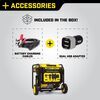









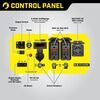
















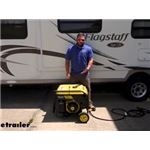









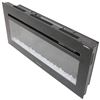


















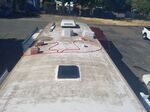

Thank you! Your comment has been submitted successfully. You should be able to view your question/comment here within a few days.
Error submitting comment. Please try again momentarily.